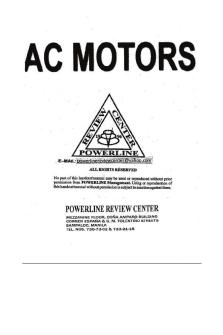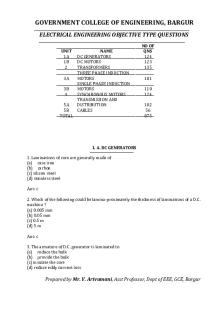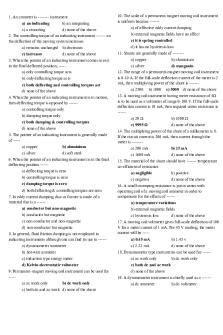Basic Electrical Engineering VIVA Questions PDF

| Title | Basic Electrical Engineering VIVA Questions |
|---|---|
| Author | Pagal Pagal |
| Course | Software Engineering |
| Institution | Osmania University |
| Pages | 4 |
| File Size | 141.8 KB |
| File Type | |
| Total Downloads | 177 |
| Total Views | 356 |
Summary
*(Basic Electrical Engineering) * *VIVA VOCE *EXPERIMENT ‐1 TO VERIFY KVL AND KCL IN GIVEN CIRCUIT1) Difference between loop and mesh? Ans. Loop : A loop ** is a closed path in a circuit where two nodes are not traversed twice except the initial point, which is also the final one. But in a *loop * o...
Description
(BasicElectricalEngineering) VIVAVOCE EXPERIMENT‐1TOVERIFYKVLANDKCLINGIVENCIRCUIT 1)Differencebetweenloopandmesh? Ans. Loop:Aloopisaclosedpathinacircuitwheretwonodesarenottraversed twiceexcepttheinitialpoint,whichisalsothefinalone.Butinaloopother pathscanbeincludedinside. Mesh:Ameshisaclosedpathinacircuitwithnootherpathsinsideit.Inother words,aloopwithnootherloopsinsideit. 2)Whatisopencircuitandshortcircuit? Ans.Opencircuit‐Anincompleteelectricalcircuitinwhichnocurrentflows. shortcircuit‐anelectricalcircuitinadeviceoflowerresistancethanthatofa normalcircuit,especiallyoneresultingfromtheunintendedcontactof componentsandconsequentaccidentaldiversionofthecurrent. 3)WhatisthemaindifferencewhileapplyingKirchhoff’slawind.canda.c circuits? Ans.ForDCcircuits,analgebraicsumisrequired.ForACcircuits,aphasorsum isrequired. ‐‐‐‐‐‐‐‐‐‐‐‐‐‐‐‐‐‐‐‐‐‐‐‐‐‐‐‐‐‐‐‐‐‐‐‐‐‐‐‐‐‐‐‐‐‐‐‐‐‐‐‐‐‐‐‐‐‐‐‐‐‐‐‐‐‐‐‐‐‐‐‐‐‐‐‐‐‐‐‐‐‐‐‐‐‐‐‐‐‐‐‐‐ EXPERIMENT‐2TOVERIFYSUPERPOSITIONTHEOREM 1)Whatisthenatureofcircuitonwhichsuperpositiontheoremcanbe applied? Ans.theSuperpositionTheoremworksonlyforcircuitsthatarereducibleto series/parallelcombinationsforeachofthepowersourcesatatime(thus,this theoremisuselessforanalyzinganunbalancedbridgecircuit). ‐‐‐‐‐‐‐‐‐‐‐‐‐‐‐‐‐‐‐‐‐‐‐‐‐‐‐‐‐‐‐‐‐‐‐‐‐‐‐‐‐‐‐‐‐‐‐‐‐‐‐‐‐‐‐‐‐‐‐‐‐‐‐‐‐‐‐‐‐‐‐‐‐‐‐‐‐‐‐‐‐‐‐‐‐‐‐‐‐‐‐‐‐
EXPERIMENT‐3TOVERIFYMAXIMUMPOWERTRANSFERTHEOREM 1)Whatisloadmatching? Ans.Thevaryingoftheimpedanceofaloadcircuit,soastomatchthatofa source.Thishelpsinsurethatthemaximumpossiblepoweristransferredfrom sourcetoload. 2)Whatismaximumpowertransferformula? Ans. Powerdeliveredtotheloadresistance 3)Whatisthereasonthatterminalvoltageislessthanemf? Ans. Becauseemfisthepotentialdifferenceacrossthetwoterminalsofavoltage sourcewhenitisnotconnectedtoanycircuit.Andonceitisconnectedtoa circuit,thevoltagereducesslightlybecauseoftheinternalresistanceofthe voltagesource. 4)Whatistheresistanceofidealvoltagesource? Ans.Areal‐worldvoltagesourcehasaverylow,butnon‐zerointernal resistance&outputimpedance:oftenmuchlessthan1ohm.Conversely,a currentsourceprovidesaconstantcurrent,aslongastheloadconnectedto thesourceterminalshassufficientlylowimpedance. 5)Howistheammeterconnectedinthecircuit? Ans.anammeterisconnectedinserieswithadevicetomeasureitscurrent. 6)Tofindthevoltagedropacrossaresistor,whereshouldthevoltmeterbe connected? Ans.Avoltmeterisattachedparalleltotheresistor. ‐‐‐‐‐‐‐‐‐‐‐‐‐‐‐‐‐‐‐‐‐‐‐‐‐‐‐‐‐‐‐‐‐‐‐‐‐‐‐‐‐‐‐‐‐‐‐‐‐‐‐‐‐‐‐‐‐‐‐‐‐‐‐‐‐‐‐‐‐‐‐‐‐‐‐‐‐‐‐‐‐‐‐‐‐‐‐‐‐‐‐‐‐ EXPERIMENT‐4TOVERIFYRECIPROCITYTHEOREM. Q1)Canyouapplyreciprocitytheoremforamultisourcenetwork? Ans)Thelimitationofthistheoremisthatitisapplicableonlytosinglesource networksandnotinthemulti‐sourcenetwork.Thenetworkwherereciprocity theoremisappliedshouldbelinearandconsistofresistors,inductors, capacitorsandcoupledcircuits.Thecircuitshouldnothaveanytime‐varying elements. ‐‐‐‐‐‐‐‐‐‐‐‐‐‐‐‐‐‐‐‐‐‐‐‐‐‐‐‐‐‐‐‐‐‐‐‐‐‐‐‐‐‐‐‐‐‐‐‐‐‐‐‐‐‐‐‐‐‐‐‐‐‐‐‐‐‐‐‐‐‐‐‐‐‐‐‐‐‐‐‐‐‐‐‐‐‐‐‐‐‐‐‐‐
EXPERIMENT‐5 TOSTUDYANDTHEVENINSTHEOREM. TOSTUDYANDVERIFYNORTON’STHEOREM. Q1)Towhattypeofnetworknorton’stheoremapplicable? Ans‐NortontheoremisuseforcomplexcircuitoryoucanseeitisuseforDC circuit.
Q2)WhatisplacedinplaceofvoltagesourceswhilecalculatingtheRN? Ans)Removeallsourcesofemfandreplacethembytheirinternalresistance orifacurrentsourceexists,replaceitwithopencircuit. Q3)Giveanexampleofunilateralcircuit? Ans)Dioderectifieristhebestexampleofunilateralcircuitbecauseitdoes notperformtherectificationinbothdirectionofsupply. Q4)Whatisunilateralcircuit? Ans)Inunilateralcircuits,thepropertyofcircuitchangeswiththechangeof directionofsupplyvoltageorcurrent.Inotherwords,unilateralcircuitallows thecurrenttoflowonlyinonedirection.Dioderectifieristhebestexampleof
unilateralcircuitbecauseitdoesnotperformtherectificationinbothdirection ofsupply. Q5)Giveoneexampleofbilateralnetwork? Ans)Bi‐lateralcircuits Inbilateralcircuits,thepropertyofcircuitdoesnotchangewiththechangeof directionofsupplyvoltageorcurrent.Inotherwords,bilateralcircuitallows thecurrenttoflowinbothdirections. Example‐Transmissionlineisthebestexampleofbilateralcircuitbecause,if yougivesupplyfromanydirection,thecircuitpropertiesremainconstant ...
Similar Free PDFs

AC Motors101 Electrical Engineering
- 17 Pages

Basic Electrical Notes answers
- 3 Pages

Viva questions
- 6 Pages

Electrical engineering - Wikipedia
- 18 Pages
Popular Institutions
- Tinajero National High School - Annex
- Politeknik Caltex Riau
- Yokohama City University
- SGT University
- University of Al-Qadisiyah
- Divine Word College of Vigan
- Techniek College Rotterdam
- Universidade de Santiago
- Universiti Teknologi MARA Cawangan Johor Kampus Pasir Gudang
- Poltekkes Kemenkes Yogyakarta
- Baguio City National High School
- Colegio san marcos
- preparatoria uno
- Centro de Bachillerato Tecnológico Industrial y de Servicios No. 107
- Dalian Maritime University
- Quang Trung Secondary School
- Colegio Tecnológico en Informática
- Corporación Regional de Educación Superior
- Grupo CEDVA
- Dar Al Uloom University
- Centro de Estudios Preuniversitarios de la Universidad Nacional de Ingeniería
- 上智大学
- Aakash International School, Nuna Majara
- San Felipe Neri Catholic School
- Kang Chiao International School - New Taipei City
- Misamis Occidental National High School
- Institución Educativa Escuela Normal Juan Ladrilleros
- Kolehiyo ng Pantukan
- Batanes State College
- Instituto Continental
- Sekolah Menengah Kejuruan Kesehatan Kaltara (Tarakan)
- Colegio de La Inmaculada Concepcion - Cebu











